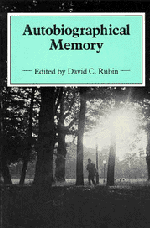Book contents
- Frontmatter
- Contents
- List of contributors
- Preface
- Part I Overview
- Part II Historical, theoretical, and methodological contexts for the study of autobiographical memory
- Part III The general organization of autobiographical memory
- Part IV The temporal organization of autobiographical memory
- Part V Temporal distributions of autobiographical memories
- 11 Childhood amnesia: an empirical demonstration
- 12 Autobiographical memory across the lifespan
- Part VI Failures of autobiographical memory
- Author index
- Subject index
12 - Autobiographical memory across the lifespan
Published online by Cambridge University Press: 01 March 2011
- Frontmatter
- Contents
- List of contributors
- Preface
- Part I Overview
- Part II Historical, theoretical, and methodological contexts for the study of autobiographical memory
- Part III The general organization of autobiographical memory
- Part IV The temporal organization of autobiographical memory
- Part V Temporal distributions of autobiographical memories
- 11 Childhood amnesia: an empirical demonstration
- 12 Autobiographical memory across the lifespan
- Part VI Failures of autobiographical memory
- Author index
- Subject index
Summary
Introduction
Autobiographical memory is a topic that inherently involves a lifespan approach. The development of autobiographical memory in the individual raises issues starting with childhood amnesia and progressing to reminiscence and life review. This chapter analyzes the results of studies from several different laboratories. Together, these studies cover the adult lifespan. In all cases, the data are the dates of autobiographical memories that have been cued by words. In all cases, the dependent measure is the distribution of the memories across the individual's lifespan.
The structure of the chapter is as follows. First, the cuing method used to elicit memories is described. Next, the data obtained with college students are examined in terms of a laboratory retention function. Possible extentions of this retention function to older subjects are then considered before existing studies that use subjects of various ages are reviewed. Reanalysis of the data from these studies suggests that sampling as well as retention determines the relative accessibility of autobiographical memories of older subjects. Individuals begin to reminisce when they reach middle age; they recall a disproportionate number of memories from their early lives. These findings, which are consistent over several studies, lead to a model of autobiographical memory involving three components: retention, reminiscence, and childhood amnesia.
- Type
- Chapter
- Information
- Autobiographical Memory , pp. 202 - 222Publisher: Cambridge University PressPrint publication year: 1986
- 242
- Cited by



